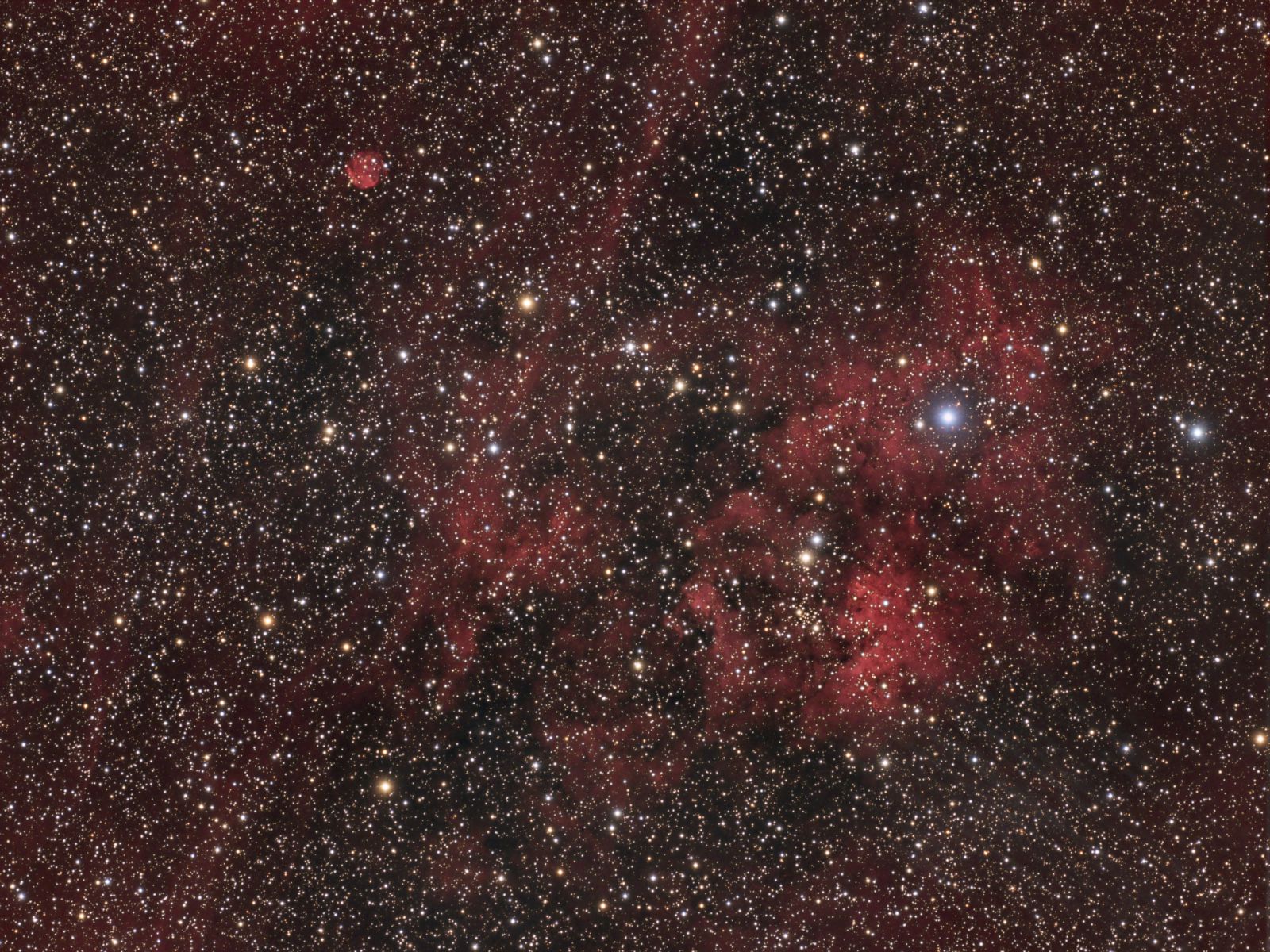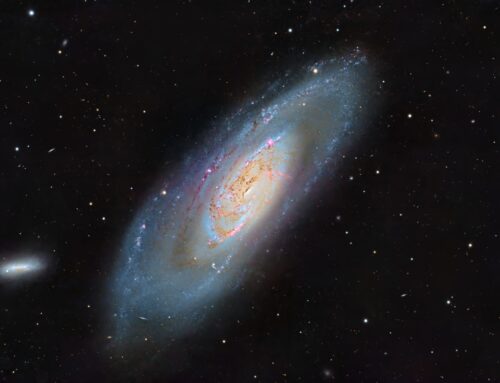Sharpless 2-115
 Click image for full size version
Click image for full size version
July 27, 2020
Sh2-115 dominates the centre and right half of the image, with round Sh2-116 at upper left. Both are members of the Sharpless catalogue of nebulae and lie in northern Cygnus, not far from the famous North America nebula. They lie about 7500 light years away. The main nebula, which shows red in this image, is powered by the stars in the open cluster Berkeley 90, which is slightly to the lower right of centre.
 The image above was acquired with broadband filters that permit all visible wavelengths through, along with a hydrogen-alpha filter that passes one specific red wavelength through to the camera’s sensor. The blue-dominant version at left was made using filters that pass specific wavelengths from sulfur, hydrogen and oxygen. This so-called Hubble Palette reveals structures that don’t show as well in the natural-colour image.
The image above was acquired with broadband filters that permit all visible wavelengths through, along with a hydrogen-alpha filter that passes one specific red wavelength through to the camera’s sensor. The blue-dominant version at left was made using filters that pass specific wavelengths from sulfur, hydrogen and oxygen. This so-called Hubble Palette reveals structures that don’t show as well in the natural-colour image.
Tekkies:
Acquisition, focusing, and control of Paramount MX mount, unguided, with TheSkyX. Focus with Optec DirectSync motor and controller. Automation with CCDCommander. Equipment control with PrimaLuce Labs Eagle 3 Pro computer. All pre-processing and processing in PixInsight. Acquired from my SkyShed in Guelph. Average or better transparency and seeing. Data acquired June 13-20, 2020 in a mostly moonless sky.
Luminance and Hydrogen alpha: Sky-Watcher Esprit 150 f/7 refractor and QHY 16200-A camera with Optolong UV/IR and H-alpha filter
Chrominance: Takahashi FSQ-106 ED IV @ f/5 and QHY367C Pro one-shot colour camera with Optolong UV/IR filter
Chrominance: 143 x 5m = 11hr55m
Total: 18hr55m
Data Reduction and Initial Processing
Preprocessing: The WeightedBatchPreProcessing script was used to create Luminance and H-alpha master frames (from the mono camera) and a RGB master frame (from the one-shot colour camera).
Gradient Removal: DBE was applied to Luminance, H-alpha and RGB masters using Subtraction.
Colour
Channel Registration: To improve channel registration, the colour channels of the RGB master were extracted and aligned with StarAlignment, using Thin Plate Splines with Distortion Correction and the luminance master as the reference frame. The registered colour channels were recombined with ChannelCombination.
Colour Balancing: Colour was balanced with PhotometricColorCalibration.
Linear Noise Reduction: MultiscaleLinearTransform was used to reduce noise in the background areas, using an internal mask to protect bright structures. Layer settings for threshold and strength: Layer 1: 5.0 0.85, 2 iterations; Layer 2: 3.5, 0.75, 2 iterations.
Stretching: HistogramTransformation was applied to make a pleasing, bright image, with background set to an intensity of approximately 0.10.
Luminance
Linear Noise Reduction: MultiscaleLinearTransform was used to reduce noise in the background areas of the Luminance-filtered image, using an internal mask to protect bright stars. Layer settings for threshold and strength: Layer 1: 3.0 0.85, 1 iterations; Layer 2: 2.0, 0.75, 2 iterations.
Stretching: HistogramTransformation was applied to make a pleasing, bright image, with background set to an intensity of approximately 0.10.
H-alpha
Deconvolution: A star mask was made to use as a Local Deringing Support image. A copy of the image was stretched to use as a range mask. Deconvolution was applied (80 iterations, regularized Richardson-Lucy, external PSF made using the PSFImage script; Global dark deringing = 0.035).
Linear Noise Reduction: MultiscaleLinearTransform was used to reduce noise in the background areas of the H-alpha image. Layer settings for threshold and strength: Layer 1: 3.0 0.9 Layer 2: 2.0, 0.75 Layer 3: 1.0, 0.6 Layer 4: 0.5, 0.2.
Stretching: HistogramTransformation was applied to the Ha to make a pleasing, bright image.
Combining Luminance, Colour and H-Alpha Images
Make LRGB: The Luminance was applied to the RGB image using LRGBCombination with default settings.
Make HaLRGB: PixelMath was used to add Ha to the LRGB image, using the following expressions for the R, G and B channels:
R: max($T[0], 1.2*Ha)
G: $T[1]
B: iif($T[0]<Ha, $T[2] + 0.06*Ha, $T[2])
Additional Processing
Nonlinear Noise Reduction: TGVDenoise was used in L*a*b* mode to reduce noise with a mask used to target the background areas and protect the stars (max. 1,000 iterations and convergence selected for both lightness and chrominance).
Contrast Enhancement: LocalHistogramEqualization was applied with a scale of 50 (max contrast 1.5, strength 0.3, 1 iteration), followed by a scale of 150 (max contrast 1.5, strength 0.23, 1 iteration).
Sharpening: MultiscaleLinearTransform was used to sharpen Layers 2 and 3 with strengths of 0.15 and 0.11, respectively. A mask was used to select only bright nebular features for sharpening.
Final Steps: Background and star brightness, contrast, and colour saturation were adjusted in several iterations using CurvesTransformation with masks as required. ExponentialTransformation was applied using a mask to protect stars and brighter parts of the nebula. ICCProfileTransformation (sRGB IEC61966-2.1; Relative Colorimetric with black point compensation) was applied prior to saving in jpg format.7






Leave A Comment